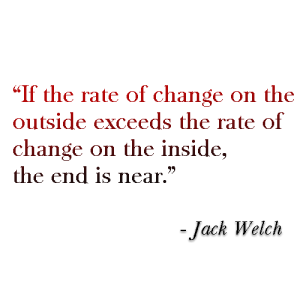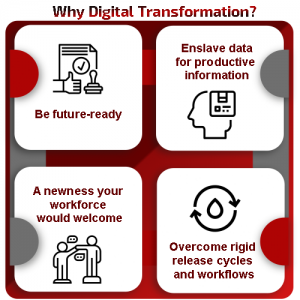 Hundreds, if not thousands, of decisions are taken every day by executives to sustain a profitable business. For ages, these decisions were derived from experience and perception of a situation. However, nowadays, data-based decisions dominate actions taken across organizations, be it product strategizing, production, resource management, or customer relationship – giving birth to the concept of digital enterprise.
Hundreds, if not thousands, of decisions are taken every day by executives to sustain a profitable business. For ages, these decisions were derived from experience and perception of a situation. However, nowadays, data-based decisions dominate actions taken across organizations, be it product strategizing, production, resource management, or customer relationship – giving birth to the concept of digital enterprise.
What is a digital enterprise?
A digital enterprise is an enterprise with the ability to gather data from all operational domains of an organization and utilize the resulting ‘digital information’ and its tools to automate and optimize performance of each operation. A digital enterprise converts operational data assets into digital formats to support decision-making to leverage next-generation computing technologies including cloud, artificial intelligence, the Internet of Things, and machine learning.
 For instance, a digital enterprise can take advantage of digital twins to foresee their conceptual products before investing on production and solve production complexities beforehand. Improved time to market, enhanced quality, and reduced cost are some of the other benefits available via digital twins for digital enterprises.
For instance, a digital enterprise can take advantage of digital twins to foresee their conceptual products before investing on production and solve production complexities beforehand. Improved time to market, enhanced quality, and reduced cost are some of the other benefits available via digital twins for digital enterprises.
Thought leaders opine that the enterprises that are “born digital” hold pole position in their race against established competitors with legacy Enterprise Resource Planning (ERP) and Customer Relationship Management (CRM) systems. For the latter, digital transformation is a process of ideating the future operational infrastructure that produces and reacts to data, deploying the new infrastructure, and utilizing it over a period for handsome return on investment (ROI); and destroy the new competitors.
Importance of Digital Enterprise Transformation
Usefulness of a digital enterprise is undeniable. According to IDG’s 2018 State of Digital Business Transformation report, mobile technologies (59%), Big Data and Analytics (58%), private cloud (53%), public cloud (45%), and APIs and embedded technologies (40%) are the top five technologies already implemented. The report reveals that 55% of startups have already adopted digital business strategies as compared to only 38% of traditional enterprises.[1] This opens tremendous opportunities for these new players to leapfrog the competition by leveraging flexible production, greater productivity, and swift development of new business strategies.
Along the similar lines, a North Carolina State University survey rates legacy technology infrastructure as the number one risk for established enterprises’ executives as opposed to those mentoring a company “born digital.”[2] The survey of CEOs, Directors, and senior executives strongly suggests that while digital enterprise transformation is the number one priority, 70% of initiatives do not reach their goals. Value-wise, out of $1.3 trillion spent on digital enterprise transformation in 2018, $900 billion went wasted!
Digital Enterprise Transformation Challenges
Based on aforementioned evidence, it is easy to adjudge that digital enterprise transformation is critical for future success, however, if and

only if done correctly. With a decade long experience in helping organizations benefit from digitilizing of operations, Infolob observes following four common challenges:
- Eliminating Employee Neophobia
Most resumes say they embraces challenges, but once the resource is hired and groomed into a process, installing changes in routines is a tough task for any management. Consequently, to complete a true digital enterprise transformation, eliminating employee neophobia and inspiring them to utilize the new operational processes for their and the company’s benefits is one of the primary challenges.
- Foreseeing the Future Down to Every Minute Detail
Besides jotting down future functionality of all operations across the organization, it is critical for a successful digital enterprise transformation to foresee the changing customer demands in the digital era. For instance, days of cable TV are now over with 5G technology paving way for pay-per-view over the top services.
It is highly recommended to analyse all assets including the existing brand, targeted customers, and the niche. Then, with market research on unmet needs, focus areas of competitors, and technology trends are essential considerations.
- Do Not Drown in Data
The essence of enterprise digital transformation is to gather data from all operations as well as from existing customers and utilize them for improved decision-making. However, Infolob observes several cases wherein mountains of data are gathered and stored, often in the form of reporting progress and customer feedback, but a proper mechanism to leverage that data is missing. An easier way here is to compile a finite list of data useful that must be gathered to produce a definite result. Once this change is installed into the new digital enterprise, some of the other data collection processes can be linked in.
- Rigid Release Cycles and Workflows
A beneficial digital enterprise transformation requires iteration over a period to identify key new features that are mission critical. Addition of new features is particularly difficult when an organization’s development process involves quarterly release cycles. Moreover, often after a logical iteration of new digital workflow, the original envision of data utilization requires restructuring. In this scenario, inflexibility of out-dated technologies causes a major hindrance.
Conclusion:
Data analysis and utilization is poised to differentiate winners from losers in the digital era, and “born digital” organizations are benefitting from it against their established competitors with legacy operational infrastructure. Consequently, “digital enterprise transformation” currently ranks as number one focus of most established businesses, but not doing it correctly leads to significant losses. Following bullet points some of the preparations to make before indulging deeper:
- Envision future scenario before making any investment
- Utilize in-house experts rather than solely depending on outside consultants unaware of inside mission-critical information and tradition
- Understand the future of customer experience and plan for increased satisfaction and intimacy rather than return on investment
- Install confidence among workforce to learn and embrace new functionalities
Research well and choose the right digital enterprise transformation experts who have successfully deployed changes to similar problems and earned accolades. Infolob too hopes to have an opportunity to demonstrate our expertise.
References:
[1] Forbes.com/sites/louiscolumbus/2018/04/22/the-state-of-digital-business-transformation-2018/
[2] Hbr.org/2019/03/digital-transformation-is-not-about-technology





